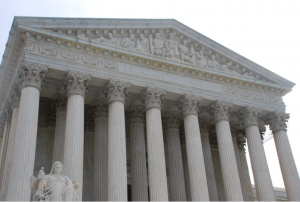By: Susanne Prochazka, RightsViews staff writer.
While the contentious Texas 6-week abortion ban, S.B.6, has caught the national spotlight, on December 1st, 2021 the Supreme Court will rule on the constitutionality of a pre-viability abortion prohibition for the first time since 1973’s seminal ruling in Roe v. Wade. In this case, Dobbs v. Jackson Women’s Health Organization, the Court will be hearing the state of Mississippi’s appeal of a lower court ruling that struck down a Mississippi law banning abortions following 15 weeks of pregnancy.
Since 2010, over 300 laws limiting the right to abortion have been enacted by various state legislatures. Many of these laws remain on the books, even where legal challenges have delayed or halted implementation of the laws going into effect. Twelve states have passed restrictions regarding “admitting privileges” laws, laws that require any doctor who performs abortions to hold active admitting privileges at a nearby hospital, similar to laws overturned in Texas and Louisiana. In 2019 and 2020, nine states enacted gestational age bans, where abortion is prohibited after a specific point in time of the pregnancy. Alabama enacted a total ban on abortion, with the procedure prohibited at any point during pregnancy, while Georgia, Kentucky, Louisiana, Mississippi and Ohio all banned abortion after a fetal heartbeat can be detected, which can occur as early as a mere six weeks into a pregnancy, before many people even know they are pregnant. In addition to states banning abortions sought for specific reasons, such as due to a fetal genetic anomaly diagnosis, four states adopted “trigger bans,” where outright bans on abortion become effective immediately, or are “triggered,” if the Supreme Court were to overturn Roe.
Dobbs v. Jackson Women’s Health Organization, however, represents the first direct challenge to Roe where a state is asking the Court to overturn the long-standing precedent in Roe where the Court held that the constitutional right to privacy in the Fourteenth Amendment extended to a woman’s right to an abortion, thus effectively legalizing the procedure across the country. In addition, as the first abortion case brought before the Supreme Court since Justice Barrett was seated, cementing a solid 6-3 conservative majority on the bench, the Court’s decision in this case bears wide-reaching ramifications on reproductive rights in the U.S.
In 2018, Mississippi enacted HB 1510, banning all abortions after 15 weeks of pregnancy, except in medical emergencies and in cases of severe fetal abnormality. Notably, there is no exception for pregnancies resulting from rape or incest. On the day HB 1510 was set to take effect, Jackson Women’s Health, the only abortion provider in Mississippi, challenged the law in federal court. The U.S. District Court for the Southern District of Mississippi and then the 5th Circuit Court of Appeals both struck the law down as unconstitutional under the precedent established in both Roe and Planned Parenthood of Southeastern Pennsylvania. v. Casey. Mississippi promptly appealed to the Supreme Court, which accepted the case for review this 2021 term.
With HB 1510, Mississippi is asking the Court to allow states to ban abortions at a point much earlier than the current viability standard established by Roe, a point where the pregnancy cannot survive outside of the pregnant person’s uterus, typically understood to be between 24 and 28 weeks of pregnancy. Upon hearing this case, the Supreme Court must determine whether all pre-viability prohibitions on elective abortions are unconstitutional. Dobbs v. Jackson Women’s Health Organization has the potential to change the viability standard and permit states to ban some or all pre-viability abortions. If the Court allows HB 1510 to stand, it will be effectively overturning Roe and Casey. 
There are three possible outcomes in Dobbs v. Jackson Women’s Health Organization. In the first possible scenario, the Supreme Court overrules Roe v. Wade, allowing states to ban or restrict all abortions before viability. In this scenario, the “trigger bans” in multiple states go into immediate effect, banning abortion access in those states. In states that do not have laws protecting abortion access, there will likely be new laws passed banning pre-viability abortions. In the second possible scenario, the Supreme Court overturns Roe v. Wade to the extent that it establishes a new standard to evaluate an undue burden and does not allow for states to ban all abortions, this decision may permit state gestational bans, driving the need for the Court to establish the parameters for a fact-based inquiry into state’s gestational ban to determine how many women seeking abortions would be burdened by these bans. In the third possible scenario, the Supreme Court affirms Roe v. Wade and its legal precedent. However, considering the current composition of the bench, with the 6-3 conservative majority, this scenario seems quite unlikely, and the Court seems poised on modifying the long-standing legal precedent established in Roe v. Wade.
Photos
Featured Image: “United States Supreme Court Courtroom” by runJMrun is licensed with CC BY 2.0. To view a copy of this license, visit https://creativecommons.org/licenses/by/2.0/
“Defend Roe V Wade” by Thomas Hawk is licensed with CC BY-NC 2.0. To view a copy of this license, visit https://creativecommons.org/licenses/by-nc/2.0/
“Supreme Court” by deltaMike is licensed with CC BY-NC-SA 2.0. To view a copy of this license, visit https://creativecommons.org/licenses/by-nc-sa/2.0/
